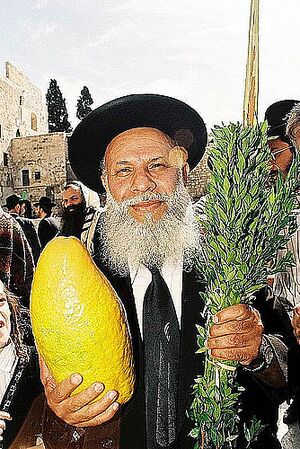Yemenite citron facts for kids
The Yemenite citron (called etrog teimani in Hebrew) is a special type of citron fruit. It's unique because it usually doesn't have the juicy parts (called juice vesicles) inside its segments. The tree that grows it and the fruit itself are often bigger than other kinds of citron trees and fruits.
What Makes It Special?
Even though the Yemenite citron looks quite different from other common citrons, scientists who study citrus fruits and genetics have confirmed it's a true citron variety. They found it's closely related to other types of citrons. A short report about this study was shared at a global citrus research meeting.
This Yemenite type is also very similar to the Moroccan citron. The Moroccan citron is grown in a faraway area where no other citrus plants are found.
Its Role as an Etrog
The Yemenite citron is the only citron without pulp that is used as an etrog by Jewish people. An etrog is one of the "Four Species" used in the Jewish holiday of Sukkot. While other pulpless citrons, like the Buddha's hand, exist in places like India and China, most Jewish communities don't know about them.
According to the Yemenite Jewish tradition, their specific type of citron has been with them since the time of The First Temple.
The "Ethiopian Citron"
The term Etrog haCushi (meaning "Ethiopian citron" in Hebrew) is mentioned in ancient Jewish texts like the Mishnah and the Babylonian and Jerusalem Talmuds. Most people think "Cush" refers to Ethiopia.
Interestingly, Ethiopian Jews didn't traditionally use the "Four Species" during Sukkot, even though they celebrated the holiday. This might have been because it was hard for them to get these plants. Some believe it was due to the influence of Karaite Judaism, which interprets the Bible differently. Karaites believe the "Four Species" are only for covering the sukkah (a temporary hut), not for a separate waving ceremony.
However, the Yemenite citron is available in Ethiopia and sold in its markets for eating. A researcher named Erich Isaac believed that the Yemenite citron is the same as the Ethiopian citron. He thought this was because Ethiopia ruled Yemen in the past.
Where It Grows Today
Growing citrons in Yemen can be tricky, especially since citron plants are sensitive.
Farmers in Yemen often graft citrus trees onto different rootstocks. Rootstocks are the lower parts of plants onto which another plant is joined. Common rootstocks used there are sour orange and Rough lemon. These help protect the trees from certain diseases. It's hard to know exactly which rootstock is used after grafting. Even with grafting, a disease called Phytophthora gummosis can still infect the trees in Yemen. But farmers can control it with good gardening practices.
Today, the main place where the Yemenite citron is grown is Israel. It is very popular there because of its beautiful look and large size.



